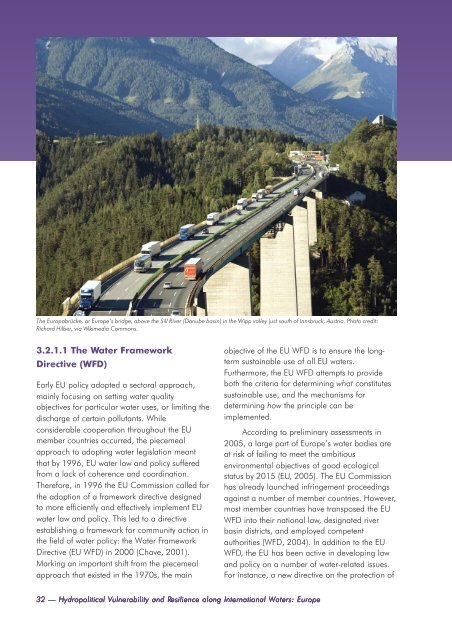Europe - UNEP
Europe - UNEP
Europe - UNEP
Create successful ePaper yourself
Turn your PDF publications into a flip-book with our unique Google optimized e-Paper software.
The Europabrücke, or <strong>Europe</strong>’s bridge, above the Sill River (Danube basin) in the Wipp valley just south of Innsbruck, Austria. Photo credit:<br />
Richard Hilber, via Wikimedia Commons.<br />
3.2.1.1 The Water Framework<br />
Directive (WFD)<br />
Early EU policy adopted a sectoral approach,<br />
mainly focusing on setting water quality<br />
objectives for particular water uses, or limiting the<br />
discharge of certain pollutants. While<br />
considerable cooperation throughout the EU<br />
member countries occurred, the piecemeal<br />
approach to adopting water legislation meant<br />
that by 1996, EU water law and policy suffered<br />
from a lack of coherence and coordination.<br />
Therefore, in 1996 the EU Commission called for<br />
the adoption of a framework directive designed<br />
to more efficiently and effectively implement EU<br />
water law and policy. This led to a directive<br />
establishing a framework for community action in<br />
the field of water policy: the Water Framework<br />
Directive (EU WFD) in 2000 (Chave, 2001).<br />
Marking an important shift from the piecemeal<br />
approach that existed in the 1970s, the main<br />
objective of the EU WFD is to ensure the longterm<br />
sustainable use of all EU waters.<br />
Furthermore, the EU WFD attempts to provide<br />
both the criteria for determining what constitutes<br />
sustainable use, and the mechanisms for<br />
determining how the principle can be<br />
implemented.<br />
According to preliminary assessments in<br />
2005, a large part of <strong>Europe</strong>’s water bodies are<br />
at risk of failing to meet the ambitious<br />
environmental objectives of good ecological<br />
status by 2015 (EU, 2005). The EU Commission<br />
has already launched infringement proceedings<br />
against a number of member countries. However,<br />
most member countries have transposed the EU<br />
WFD into their national law, designated river<br />
basin districts, and employed competent<br />
authorities (WFD, 2004). In addition to the EU<br />
WFD, the EU has been active in developing law<br />
and policy on a number of water-related issues.<br />
For instance, a new directive on the protection of<br />
32 — Hydropolitical Vulnerability and Resilience along International Waters: <strong>Europe</strong>
















